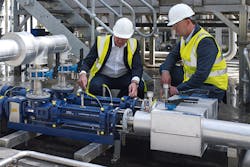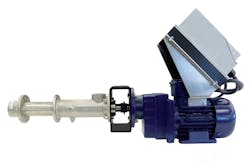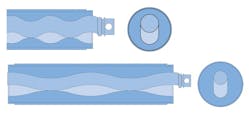Progressive cavity (PC) pumps are some of the most versatile pumps offered. They are well-accepted across numerous industries such as chemical production — especially inorganic chemicals due to their consistent flow characteristics and resistance to abrasion — and municipal water and wastewater treatment. They are common in the paper industry for coatings, flocculants and dyes, and in the oil and gas industry for oil refining and mining. PC pumps are also widely used in the food industry, especially for yogurt and fruit purees used in yogurt and ice cream.
But while PC pumps are common in so many industries, many plant-operating personnel want to avoid them because they fear chronic maintenance problems. Like any positive displacement (PD) pump, important selection and operation issues cannot be ignored. They should not be operated against a closed line or valve. Run-dry damage can be catastrophic to the elastomer stator. Choosing the correct materials, especially elastomers, is critical. These caveats are common to most PD pumps, especially those that have mechanical seals. The real problem has been that in the past, many engineers who specified PC pumps put them at a disadvantage by grossly oversizing the pumps to avoid maintenance issues. That makes the PC pump a bad bargain at the initial cost and long-term operating costs by sacrificing efficiency for longevity. It was a reaction to the difficulty in repairing a PC pump. With the tight compression fit between the rotor and stator, it was difficult to replace a stator, so it was usually best to remove the pump from the installation and do the repairs in a shop setting.
New developments in the last 30 years — and in the last 10 years in particular — have made these pumps easier to work on and have reduced the tendency to sacrifice efficiency for longevity. This has reduced the initial capital, maintenance and operating costs for PC pumps. With these developments in mind, below are guidelines for properly selecting a PC pump for specific application needs, especially related to saving operating costs through reduced energy consumption.
As few energy conversions as possible
Avoid using air as a motive power source. It is inefficient to convert electricity to rotation with an electric air compressor and then convert it back into rotational motion with an air-powered motor. Furthermore, compressed air must be cleaned, dried and de-oiled, all which rob or add power, and air lines leak much more readily than insulated wires. Generally, electrically operated pumps operate at 50 to 60 percent overall efficiency (wire to water), while air-operated pumps function at about 15 to 20 percent efficiency. Air motors also have to be sized for starting torque, which is normally higher than the running torque. A good rule of thumb is that 4 standard cubic feet per minute of compressed air consumption is equivalent to 1 hp.
Internal combustion engines have the same issues. They burn fuel inefficiently to change reciprocating motion to rotational motion. A clutch is needed because internal combustion engines have zero torque for starting. Hydraulic motors are the same — they have too many conversions and no more torque for starting than for running.
Only pump what is needed
Avoid circulation loops and control valves. The more that is pumped, the more power that is consumed.
GPM × ΔP (psi) ÷ 1714 × Overall efficiency = hp
Use variable speed drives to do only the work required. Control valves consume excess energy, as does an overproducing pump. When they are air operated, they have the same issues as air-operated pumps. Variable frequency drives (VFDs), on the other hand, are extremely efficient. Because power is delivered as volts/Hertz, running at lower speeds saves energy and operators to do only the work needed without valve losses. Using a VFD in conjunction with a properly sized discharge line for minimal energy loss to friction is the most energy-efficient way to control a PC pump’s rate of flow.
Know options: How AC electric motors work with a VFD
Personnnel are not constrained to operate at only 60 Hertz (Hz). The pump’s motor operates at operating load 99.9 percent of the time. Therefore, the motor should be sized solely on this attribute for maximum operating efficiency. A gear reduction should then be selected to meet two criteria:
The gear reduction should first supply the mechanical advantage to allow the same motor (chosen based on operating power) to start the pump, since PC pumps do not run at full motor rpms. Rising efficiency standards reduce the ratio between a motor’s locked rotor torque versus locked rotor amps. Make sure the inverter supplies enough current to produce the torque required to start the pump. Even with premium efficient motors, the traditional “15 percent motor service factor” extra power allowance does not apply when the motor is operated by a VFD.
The gear reducer should be selected so the operating frequency of an inverter falls between 50 and 100 Hz.
VFDs allow operators to change motor frequency to reduce or increase speed from the direct online frequency of 60 Hz. Most alternating current (AC) induction motors (Type-B and Type-D torque curve models) allow constant torque operation from 5 to 60 Hz. After 60 Hz, they become constant power devices.
Do not be afraid to run at higher frequencies. Think about what is different between a two-pole and a four-pole (or a six-pole or an eight-pole) motor. It is not the rotating part, field or stationary parts. The rotor and the bearings are designed for 3,600-rpm design, so running the motor at 3,000 is not a big stretch if it is correctly sized.
Do not sacrifice performance for efficiency
It is common to derate the pressure capability of a PC pump to make it last longer. The concept is pretty simple. A PC pump stage is defined as one complete pitch of the helical stator (or two pitch lengths of the rotor). With a 70-durometer elastomer and about 0.020 inches of compression between the rotor and the stator, a PC pump is nominally rated at 90 psi per stage. In an abrasive application for which a pump needs to last longer, say for 60 psi, it is common to use a two-stage pump rated for 180 psi. The concept is that the stator is deflected away from the rotor by the force of the differential pressure. When the pump is new, two-thirds of the stator (60÷90) is deflected away from the rotor. Then only one-third of the single-stage stator is compressed against the rotor. If that pump only lasts six months because of abrasion, most manufacturers would suggest using a two-stage pump. Unfortunately, that will double the starting torque and cut the overall efficiency of the pump from 50 to 40 percent. So the power consumption increases by about 25 percent and the user may need to buy a motor and gear reducer that are twice as large.
Adjustable stators are alternatives to sacrificing efficiency for longevity. Lab tests done at a major university compared a single-stage PC pump with an adjustable stator against a two-stage conventional pump. The single-stage PC pump with the adjustable stator lasted five to nine times longer and used less power than the conventional two-stage design. The adjustable stator on the single-stage pump allows users to apply only as much compression between the rotor and stator as is required to overcome the differential pressure of the application. As the elastomer erodes, the stator can be adjusted. This reduces starting torque, which reduces the current required to operate the pump. The product with an adjustable stator is available for pressures up to 120 psi. These designs offer many advantages: higher efficiencies, lower power consumption, smaller footprint, smaller motor and drive requirements and lower replacement costs.
Consider “wobble stator” pumps for lower pressure applications. For pressures less than 60 psi and flows under 55 gpm, a pump with a free-molded wobble stator may be the best choice. These pumps do not have the extreme amount of compression between the rotor and the stator, so starting torque is much less. The pressure in the pump casing increases the amount of compression between the rotor and the stator, which makes the starting torque much lower in proportion to the operating torque. These pumps are less expensive and, though limited in size and pressure, they are still well-suited for transfer and metering applications in which most of the pressure comes from static head instead of friction loss.
Correct geometry
The original or “conventional” progressive cavity geometry designed by Dr. René Moineau in 1936 has a relatively short stator pitch length with larger diameter rotors that have more eccentricity. In the 1960s, stators and rotors with longer geometry started becoming common. It used longer stator pitch lengths with smaller rotor diameters and eccentricity. This reduces thrust loads and the rate of erosion on abrasive applications and reduced energy consumption by lessening starting torque and improving overall efficiencies.
The most recent PC pump geometry is the even-wall stator (see Figure 4). The stator with the double internal helix is fixed in a similar double internal helix tube. Now the elastomer is an even thickness throughout the stator. Conventional tube stators (see Figure 3) are injection-molded into cylindrical tubes, so the seal line between the rotor and stator is at the point in the stator where the elastomer is the thickest. The even/equal wall stator is rated for double the pressure per stage of a conventional design. Again, for the work being performed, the internal static and operational friction is less than that of conventional designs when the even-wall stators are used. A two-stage conventional stator is rated for 180 psi, whereas a two-stage even-wall is rated for 360 psi. The compression between the rotor and stator (and therefore breakaway torque) is slightly increased since the even-wall deflects less, but remains much less than would be seen in a conventional, four-stage stator. It increases about 50 percent rather than double, as would be experienced when going from a two-stage to a four-stage conventional rotor/stator. Netting this out, the even-wall stator will save about 25 percent on energy consumption. Just like the adjustable stators, the even-wall has a smaller footprint, a smaller motor and gear, a less expensive replacement rotor and stator and less weight.
In conclusion, operating costs and initial capital costs can be saved in numerous ways when selecting, procuring and installing a PC pump. Make a complete overview of the application conditions, use the above techniques to optimize initial selections, and work with proven pump suppliers to choose the best solution for the facility’s needs.
Jason Ryan is regional vice president for sales — East Region at FCX Performance. He is a corporate sales management professional with expertise in strategic corporate planning, territory development, M&A transactions, corporate negotiations, P&L management and responsibility and marketing.
John Salyers is district manager — Ohio Valley for SEEPEX Inc.







